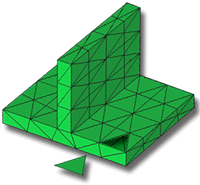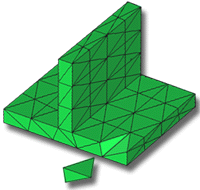Mesh types
The mesh type, or analysis technology, you select determines which molding processes and which analysis sequences are available for selection.
Dual Domain analysis technology
A surface mesh provides the basis for the analysis. This mesh consists of three-node, triangular elements that form a one-dimensional representation on each surface of the part. The mesh elements are matched across opposing faces. The thickness of the part is determined by the distance between the opposing faces.
The model could be visualized as a hollow body covered with a surface shell.
Dual Domain analysis technology is appropriate when:
- Overall the part is thin walled with few thick areas. The minimum length and width of any local region should be greater than four times the local thickness. A more conservative estimate of ten times the thickness ensures more accurate results.
- The analysis that you want to run produces results through the thickness of the part, for example, temperature, flow front, and shear rate.

3D analysis technology
3D analysis technology is appropriate when:
- The part has many thick sections, corners, features, or walls. 3D analysis technology is recommended for parts where the length and width of a section is less than four times the local thickness.
- You want to accurately model non-laminar flow around corners and features.

